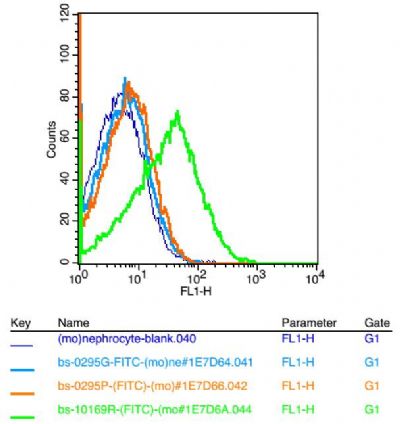产品货号 : mlR10169
英文名称 : CHRNA1
中文名称 : 烟碱型乙酰胆碱受体AChRα1抗体
别 名 : Nicotinic Acetylcholine Receptor alpha 1; Acetylcholine receptor protein alpha chain Precursor; Acetylcholine receptor subunit alpha; ACHA_HUMAN; ACHRA; CHNRA; Cholinergic receptor nicotinic alpha polypeptide 1; Cholinergic receptor, nicotinic, alpha polypeptide 1 (muscle); CHRNA1; Nicotinic cholinergic receptor alpha 1; Schizophrenia neurophysiologic defect candidate.
研究领域 : 细胞生物 神经生物学 细胞膜受体
抗体来源 : Rabbit
克隆类型 : Polyclonal
交叉反应 : Human, Mouse, Rat, Dog, Pig, Cow, Horse, Sheep,
产品应用 : WB=1:500-2000 ELISA=1:500-1000 IHC-P=1:400-800 IHC-F=1:400-800 Flow-Cyt=1μg/Test ICC=1:100-500 IF=1:100-500 (石蜡切片需做抗原修复)
not yet tested in other applications.
optimal dilutions/concentrations should be determined by the end user.
分 子 量 : 54kDa
细胞定位 : 细胞膜
性 状 : Lyophilized or Liquid
浓 度 : 1mg/ml
免 疫 原 : KLH conjugated synthetic peptide derived from human CHRNA1:175-280/482 <Extracellular>
亚 型 : IgG
纯化方法 : affinity purified by Protein A
储 存 液 : 0.01M TBS(pH7.4) with 1% BSA, 0.03% Proclin300 and 50% Glycerol.
保存条件 : Store at -20 °C for one year. Avoid repeated freeze/thaw cycles. The lyophilized antibody is stable at room temperature for at least one month and for greater than a year when kept at -20°C. When reconstituted in sterile pH 7.4 0.01M PBS or diluent of antibody the antibody is stable for at least two weeks at 2-4 °C.
PubMed : PubMed
产品介绍 : Members of the ligand-gated ion channel receptor family are characterized by their fast transmitting response to neurotransmitters. Two important members of this family are the nicotinic acetylcholine and glutamate receptors, both of which are composed of five homologous subunits forming a transmembrane aqueous pore. These transmembrane receptors change conformation in response to their cognate neurotransmitter. Nicotinic acetylcholine receptors (AChRs) are found at the postsynaptic membrane of the neuromuscular junction and bind acetylcholine molecules, allowing ions to move through the pore. Glutamate receptors are found in the postsynaptic membrane of cells in the central nervous system. The activity that is generated at the synapse by the binding of acetylcholine is terminated by acetylcholinesterase, an enzyme that rapidly hydrolyzes acetylcholine. AChR?, also known as ACHRD, CHRNA, CMS2A, FCCMS, SCCMS or CHRNA1, is a 482 amino acid multi-pass membrane protein that exists as two alternatively spliced isoforms, which are expressed in different tissues. Isoform 1 is only expressed in skeletal muscle whereas isoform 2 is constitutively expressed in skeletal muscle, brain, heart, kidney, liver, lung and thymus.
Function:
After binding acetylcholine, the AChR responds by an extensive change in conformation that affects all subunits and leads to opening of an ion-conducting channel across the plasma membrane.
Subunit:
Pentamer of two alpha chains, and one each of the beta, delta, and gamma (in immature muscle) or epsilon (in mature muscle) chains.
Subcellular Location:
Cell junction, synapse, postsynaptic cell membrane; Multi-pass membrane protein. Cell membrane; Multi-pass membrane protein.
Tissue Specificity:
Isoform 1 is only expressed in skeletal muscle. Isoform 2 is constitutively expressed in skeletal muscle, brain, heart, kidney, liver, lung and thymus.
DISEASE:
Defects in CHRNA1 are a cause of multiple pterygium syndrome lethal type (MUPSL) [MIM:253290]. Multiple pterygia are found infrequently in children with arthrogryposis and in fetuses with fetal akinesia syndrome. In lethal multiple pterygium syndrome there is intrauterine growth retardation, multiple pterygia, and flexion contractures causing severe arthrogryposis and fetal akinesia. Subcutaneous edema can be severe, causing fetal hydrops with cystic hygroma and lung hypoplasia. Oligohydramnios and facial anomalies are frequent.
Note=The alpha subunit is the main focus for antibody binding in myasthenia gravis. Myasthenia gravis is characterized by sporadic muscular fatigability and weakness, occurring chiefly in muscles innervated by cranial nerves, and characteristically improved by cholinesterase-inhibiting drugs.
Defects in CHRNA1 are a cause of congenital myasthenic syndrome slow-channel type (SCCMS) [MIM:601462]. SCCMS is the most common congenital myasthenic syndrome. Congenital myasthenic syndromes are characterized by muscle weakness affecting the axial and limb muscles (with hypotonia in early-onset forms), the ocular muscles (leading to ptosis and ophthalmoplegia), and the facial and bulbar musculature (affecting sucking and swallowing, and leading to dysphonia). The symptoms fluctuate and worsen with physical effort. SCCMS is caused by kinetic abnormalities of the AChR, resulting in prolonged endplate currents and prolonged AChR channel opening episodes.
Defects in CHRNA1 are a cause of congenital myasthenic syndrome fast-channel type (FCCMS) [MIM:608930]. FCCMS is a congenital myasthenic syndrome characterized by kinetic abnormalities of the AChR. In most cases, FCCMS is due to mutations that decrease activity of the AChR by slowing the rate of opening of the receptor channel, speeding the rate of closure of the channel, or decreasing the number of openings of the channel during ACh occupancy. The result is failure to achieve threshold depolarization of the endplate and consequent failure to fire an action potential.
Similarity:
Belongs to the ligand-gated ion channel (TC 1.A.9) family.
Acetylcholine receptor (TC 1.A.9.1) subfamily. Alpha-1/CHRNA1 sub-subfamily.
SWISS:
P02708
Gene ID:
1134
Important Note:
This product as supplied is intended for research use only, not for use in human, therapeutic or diagnostic applications.
产品图片












